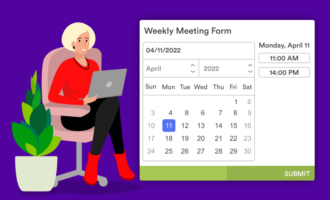Now that more companies are building remote work environments because of the COVID-19 pandemic, it’s important to ensure each virtual meeting returns sufficient value for the time remote team members spend in it.
Regardless if it’s face-to-face or remote, no one wants to spend extra time in a meeting if they don’t have to. These events need to be planned to maintain team productivity.
Here are 10 tips to create effective remote team meetings:
1. Determine the meeting’s purpose
The most effective team meetings are necessary team meetings. So many business meetings seem to be ends unto themselves. With the lack of face-to-face time, a meeting may become an excuse to simply touch base and visually connect.
It might be more effective to have a Slack or Microsoft Teams chat to provide a quick update to a couple of people. Alternatively, you can use FaceTime or Skype to check in, clarify an issue, or brainstorm with a colleague.
2. Improve team meetings with tools
Use tools like customized feedback forms from Jotform to evaluate and improve team meetings. These forms allow your remote workers to share their input and ideas on creating more effective video or audio meetings.
You can also use Jotform to set up meetings through its Zoom video conferencing integration. The integration alerts invited team members to an upcoming meeting so they can easily confirm and join.
3. Be prepared
When all attendees plan ahead what they want to share at the meeting, it adds value for everyone who attends while making the best use of the meeting time. Each speaker or participant can write down bullet points to frame their comments or meeting segment.
4. Account for time zones and schedules
Plan the remote meeting to fit everyone’s schedules. Video conferencing tools offer ways to integrate team calendars and automate invitations, including setting time zone information for each participant. Scheduling the remote meeting to show up on each attendee’s calendar helps everyone remember to be there.
5. Stick to the meeting time (or end early)
Use a timer, which often comes with video conferencing software, to track time throughout the meeting. This helps everyone focus on working through the agenda and avoids eating into your team’s productivity for the day.
6. Leverage video conference features to enhance the meeting
Today’s video calls do more than just recreate the feel of in-person meetings. Many video conferencing tools help attendees get more from the meeting. This includes screen sharing to simplify the discussion of specific projects and facilitate decision-making during the meeting.
Many video conference service providers offer ways to automate meeting invitations and attendance. Other tools for recording and transcribing meetings make it easy to follow up on action items and update those who can’t attend.
7. Practice remote meeting etiquette
Meeting attendees need to follow some basic etiquette to stay focused and get the most out of their time together. This includes not answering other emails, responding to text messages, or browsing other sites.
Mute your microphone when you aren’t speaking, and don’t eat or drink while on the conference call. Be sure that other people in your home know that you’re on a video call so they don’t disrupt it.
Also, be sure to announce yourself when you join a call, especially if you aren’t using a camera. Be respectful of other people speaking. Wait for your turn to speak, or use the “Raise your hand” feature available on many video conferencing platforms.
8. Create an agenda and share it in advance
Effective remote meetings are guided by an agenda. This keeps everyone on task and moves the meeting along. Focus the meeting agenda on the action items you need to address to accomplish the purpose of the meeting. This will help reduce or eliminate tangents.
9. Have a remote team meeting leader
For all conference calls, appoint a leader who oversees meeting flow and keeps everything on schedule. They can keep an eye on the time and gently remind speakers when to move to the next action item.
10. Limit speakers and comments
Reducing the number of speakers keeps the small talk to a minimum and avoids wasting time. Ask attendees to provide only comments that contribute to the meeting’s purpose. Encourage everyone to save other thoughts for later individual discussions.












































































































Send Comment: